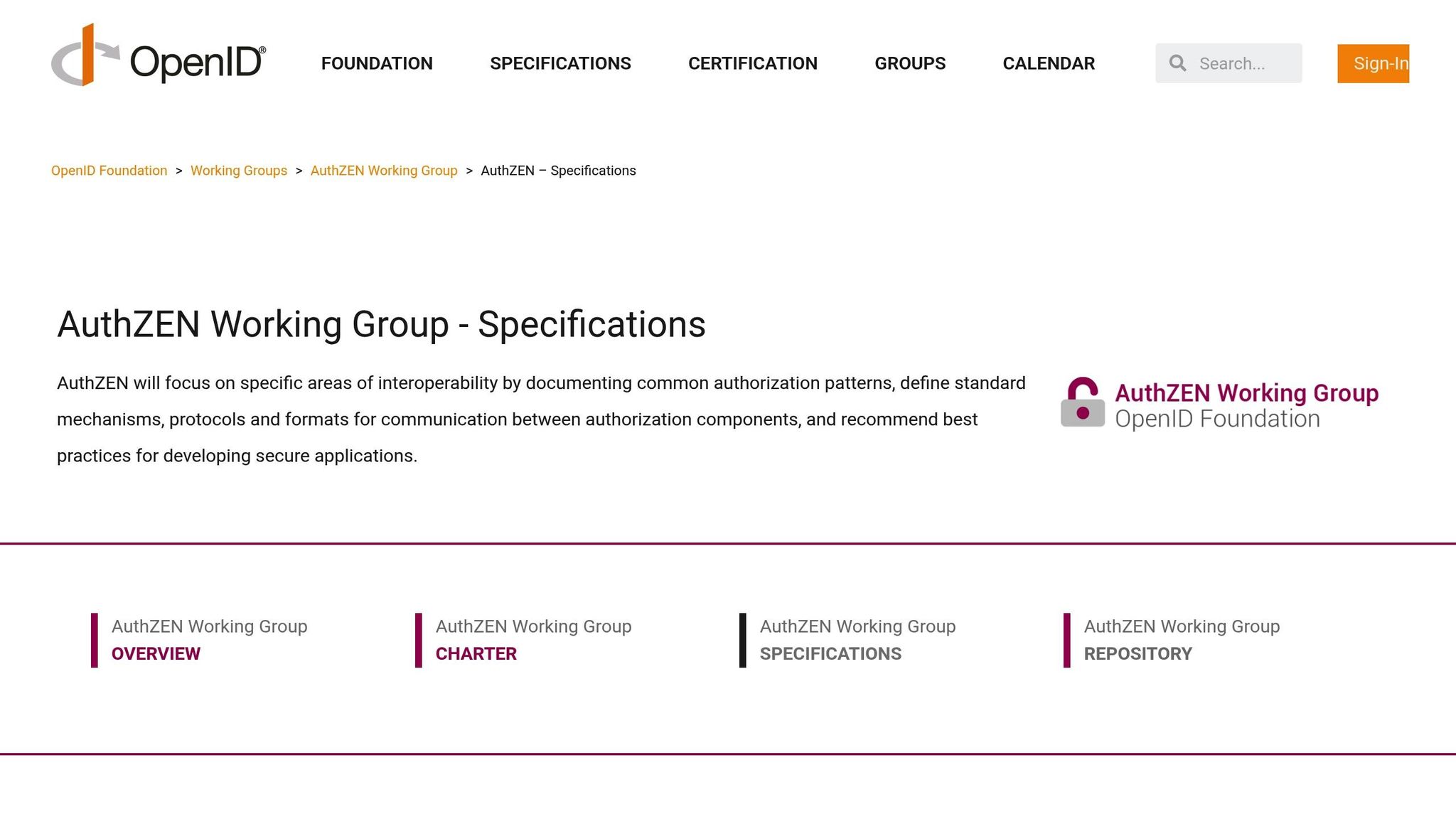Policy enforcement and governance are two essential elements of API management in B2B systems. While policy enforcement ensures real-time rules like authentication, rate limiting, and security protocols are applied to API requests, governance establishes long-term standards for API design, compliance, and lifecycle management. Together, they create secure, scalable, and consistent API ecosystems.
Key Takeaways:
- Policy Enforcement: Focuses on runtime controls through API gateways.
- Example: Enforcing OAuth2, rate limits, and data validation.
- Governance: Provides a framework for consistent API standards.
- Example: Defining API versioning, documentation, and compliance rules.
Why Both Matter:
- Enforcement ensures immediate security and reliability.
- Governance ensures consistent practices across APIs and aligns with business goals.
- Combining both reduces risks, simplifies compliance, and enhances partner integrations.
Quick Tip: Start by forming a governance team to create standards, then integrate them into API gateways for automated enforcement. Regularly monitor and update policies to keep up with evolving needs.
Fine grained gateway enforced authorization with OpenID AuthZen

What Is Policy Enforcement in API Gateways
Policy enforcement in API gateways refers to the centralized application of rules that govern how API requests and responses are processed in real time. By managing security and operational policies at the infrastructure level, API gateways ensure consistent behavior across all APIs under their control.
When an API request comes in, the gateway automatically evaluates it against a set of predefined rules. Only requests that meet these requirements are allowed to proceed to backend services. Let’s break down the key features that make this enforcement process work.
Policy Enforcement Definition and Core Features
Policy enforcement relies on several key mechanisms designed to secure and manage API traffic effectively:
- Authentication Policies: These use OAuth2 token validation to verify that only authorized users can access protected resources.
- Rate Limiting: Controls the number of requests a client can make within a specific timeframe, helping prevent abuse while keeping system performance stable.
- SSL/TLS Termination: Encrypts data in transit, ensuring secure communication between clients and the gateway.
- CORS Management: Regulates which web domains can access the API, preventing unauthorized cross-site requests.
- Request and Response Transformation: Modifies payloads or headers to handle tasks like converting data formats or adding security headers.
- Access Logging: Tracks every API interaction, creating audit trails essential for troubleshooting and meeting compliance standards.
- Custom Logic Execution: Allows businesses to implement specific rules or validations that go beyond standard security measures.
These tools are highly adaptable, enabling organizations to combine them in ways that align with their specific security, compliance, and operational goals - all while maintaining centralized control.
How Policy Enforcement Works in API Gateways
The enforcement process starts when the API gateway intercepts incoming requests. It evaluates each request against the configured policies before deciding whether to forward it to backend services. If a request fails to meet any of the policies - such as missing proper authentication or exceeding rate limits - the gateway blocks it and returns a relevant error message.
For example, OAuth2 ensures secure access by validating tokens and determining user permissions without exposing backend credentials. SSL/TLS encryption protects communication, while transformation engines adjust data formats or enhance payloads as needed. Imagine a scenario where a legacy system sends XML data: the gateway can convert it to JSON for compatibility with modern applications. Similarly, additional security headers can be appended to outgoing responses to meet compliance needs.
Throughout this process, the gateway monitors policy applications in real time. It logs successful authentications, blocked requests, and any violations. This constant oversight not only helps address security threats quickly but also provides valuable data for compliance reporting.
Policy Enforcement Benefits for B2B Systems
Centralized policy enforcement brings numerous advantages, especially for B2B systems. By standardizing authentication and authorization controls, it ensures consistent security across all API interactions. This eliminates potential gaps that might emerge when individual APIs handle security differently.
Automation also plays a big role. Proven policy templates can take care of repetitive tasks like authentication, rate limiting, and compliance checks, saving time and reducing errors. For industries that must meet regulatory standards such as PCI DSS or HIPAA, this uniform approach simplifies compliance by ensuring all APIs adhere to the same rules.
Another benefit is streamlined partner onboarding. Instead of creating custom security measures for each partner, organizations can provide a single set of documented policy requirements, making the process faster and more efficient.
Finally, centralized enforcement reduces risk through continuous monitoring and logging. Suspicious activity triggers immediate alerts, and detailed audit trails make it easier to investigate and respond to potential threats. This proactive approach strengthens security while supporting operational efficiency.
API Governance Explained for B2B Platforms
API governance operates as the strategic backbone of how APIs are designed, developed, and managed throughout their lifecycle. While policy enforcement focuses on the real-time application of rules, governance sets the long-term framework that guides decision-making. It lays out the blueprint for everything from API design to eventual retirement.
API Governance Definition
API governance is a structured framework of policies, standards, and processes that guide the creation and management of APIs across an organization. In B2B contexts, this framework ensures that APIs are developed and maintained using consistent rules, enabling secure, reliable, and scalable integrations between business partners.
Governance goes beyond enforcing rules - it defines the rationale and standards behind them. It establishes the decision-making processes for critical aspects like security protocols, documentation practices, versioning strategies, and compliance requirements.
For example, governance addresses questions like: How should APIs adapt to meet evolving business needs? What standards will simplify partner integrations? How can organizations meet regulatory requirements without slowing development? These high-level considerations are essential for managing APIs effectively in complex B2B environments.
Main Parts of API Governance
API governance consists of several key components that ensure consistency, quality, and reliability across your API ecosystem. Each plays a specific role in reducing risk and maintaining standards.
- Versioning: This ensures APIs can evolve without disrupting existing integrations. For instance, if a payment API adds new fraud detection features, proper versioning allows current partners to continue using the existing version while new partners adopt the updated one. This approach avoids breaking integrations, which is critical in B2B relationships where changes require careful coordination.
- Documentation: Clear, standardized documentation - often based on specifications like OpenAPI - minimizes integration errors and speeds up partner onboarding. It provides developers with a consistent format that’s easy to understand and implement.
- Security Protocols: Governance enforces consistent authentication and authorization standards, like requiring OAuth2 for authentication and HTTPS for data transport. This uniformity reduces vulnerabilities and simplifies security audits by eliminating ad-hoc security implementations.
- Compliance Mandates: APIs must meet regulatory requirements such as GDPR, HIPAA, or PCI DSS. For example, in healthcare B2B networks, governance frameworks often include strict data validation and encryption protocols to ensure HIPAA compliance.
- Design Standards: Consistency in naming conventions, error handling, and data formats makes integrations more predictable and less prone to errors. For example, using uniform endpoint naming and response structures simplifies onboarding for new partners.
These components are essential for mitigating inconsistencies. Studies show that over 90% of organizations have faced API-related security issues, often due to inconsistent policies or poorly implemented standards. A strong governance framework helps eliminate these vulnerabilities by ensuring uniform application of security and quality measures.
How Governance Supports B2B Success
Effective API governance aligns your entire API ecosystem with broader business goals, enabling scalability and adaptability in complex B2B environments.
Clear governance standards streamline partner integration by defining consistent authentication and security requirements. This reduces the time and resources needed for integrations while ensuring the API ecosystem can adapt to future changes. For example, when new regulations or market demands arise, governance provides the structure to update APIs consistently across the board.
Additionally, governance promotes operational efficiency. By leveraging established patterns and reusable components, development teams can accelerate delivery without sacrificing quality. This efficiency becomes increasingly important as API portfolios grow and partnerships expand.
Most importantly, robust governance builds trust in B2B relationships. When partners see that your APIs adhere to consistent standards for security, documentation, and reliability, they can integrate with confidence. This trust not only strengthens existing partnerships but also gives your business a competitive edge in forming new ones.
sbb-itb-01010c0
Policy Enforcement vs. Governance: Key Differences and How They Work Together
Grasping the distinct yet interconnected roles of policy enforcement and governance is key to managing APIs effectively in B2B systems. Below, we’ll break down their differences and explore how enforcement brings governance policies to life in real time.
Main Differences Between Policy Enforcement and Governance
Policy enforcement and governance operate on different levels, each playing a unique role in your API strategy. Here's how they compare:
| Aspect | Policy Enforcement | Governance |
|---|---|---|
| Scope | Specific, operational rules at runtime | Organization-wide standards and processes |
| Focus | Real-time control and compliance | Strategic consistency and quality |
| Responsibility | API gateway, runtime systems | Governance team, Center of Excellence |
| Impact | Immediate security and reliability | Long-term scalability, compliance, and innovation |
| Example | Enforcing OAuth2, rate limiting | Defining API design standards and compliance |
Imagine a partner accessing your payment API. Policy enforcement kicks in by verifying OAuth2 credentials, checking rate limits, and validating data formats in real time. Meanwhile, governance works behind the scenes at a broader level, setting standards like requiring OAuth2 for authentication. Governance teams define rules for API design, security protocols, and versioning across the organization.
The division of responsibilities is also clear-cut. Enforcement is managed by technical teams handling API gateways and runtime systems, while governance involves cross-functional groups - architects, security experts, compliance officers, and business stakeholders all contribute.
How Policy Enforcement Puts Governance Into Action
While governance provides the framework, policy enforcement ensures those rules are applied consistently at runtime.
For example, if governance mandates that all APIs use HTTPS, the API gateway enforces this requirement automatically. Similarly, a payment API governed by PCI DSS standards will rely on enforcement to handle encryption, logging, and access controls.
This alignment ensures governance policies don’t just sit on paper. Studies reveal that over 90% of organizations have faced API-related security issues, often because governance policies weren’t enforced properly at runtime. Enforcement mechanisms not only close this gap but also generate logs that help governance teams refine their standards.
Why B2B API Management Needs Both
Policy enforcement and governance each address specific needs, and together, they provide a comprehensive approach to API management. In B2B systems, which handle sensitive data and complex partnerships, this combination is essential.
Relying only on governance leaves APIs vulnerable. Without enforcement, documented standards and security protocols might not be consistently applied. On the flip side, enforcement without governance can lead to inconsistent rules that fail to align with broader business goals. For instance, rate limiting might be applied unevenly, or different authentication methods could confuse partners and complicate integrations.
By combining both approaches, you ensure immediate protection and long-term stability. When a new partner integrates with your APIs, enforcement prevents unauthorized access and system overload, while governance ensures the integration follows consistent patterns as your business grows.
As your API ecosystem expands, this dual approach becomes even more critical. The B2B Ecosystem supports organizations by offering consulting services that integrate governance frameworks with enforcement best practices, ensuring your API strategies remain secure, scalable, and aligned with business goals.
Lastly, this integration builds trust with business partners. When your APIs consistently follow documented standards and enforce security measures, partners feel confident in deepening their integrations and expanding their use of your services.
Best Practices for Combining Policy Enforcement and Governance
To strengthen B2B API management, blending governance frameworks with policy enforcement is essential. This involves creating clear processes, leveraging automation, and ensuring continuous alignment between governance standards and runtime policies.
Setting Up Governance Frameworks
Start by forming a dedicated governance team or Center of Excellence (CoE). This cross-functional group should bring together architects, security experts, product owners, and business stakeholders who understand both technical and business goals.
The governance team’s mission is to craft policies tailored to your business needs and regulatory obligations. Address specifics like semantic versioning for policy updates, standardized approval workflows, and escalation procedures for policy violations. For instance, financial services companies must comply with PCI DSS, while healthcare organizations need to meet HIPAA requirements. Clearly incorporating these regulatory needs into governance policies simplifies enforcement and ensures compliance.
Adopt governance models that strike a balance between centralized control and local flexibility. This allows a central team to define universal standards while enabling development teams to adjust policies for unique requirements, such as regional data protection laws or specific partner integrations.
Once the governance framework is established, the next step is embedding these standards directly into your API gateways.
Adding Policy Enforcement to API Gateways
API gateways are the backbone of policy enforcement, translating governance standards into actionable, runtime controls. Design policies as reusable modules to ensure consistent enforcement across APIs and environments.
Begin by implementing key enforcement policies that address critical governance needs. These include authentication and authorization controls, transport security, rate limiting, and schema validation. Each policy should function as a modular component, allowing flexibility and ease of integration.
Versioning and auditability are crucial. Store policy code in source control to track changes, enable rollbacks, and maintain compliance. Use semantic versioning to document updates clearly and ensure proper change management.
Establish separate environments for policy lifecycle management - development, testing, and production. This setup minimizes risks by thoroughly testing policy changes before they affect live traffic, safeguarding partner integrations and preventing security lapses.
Automate testing to validate policy logic before deployment. Include simulation scenarios that mimic real API usage patterns to catch potential issues early, ensuring smooth operations for your B2B partners.
Monitoring and Updating Enforcement Rules
Once enforcement policies are in place, continuous monitoring and updates are vital to maintain compliance and effectiveness. Monitor API usage patterns, detect anomalies, and regularly review policy performance to identify improvement areas.
Track key metrics such as API uptime, security incidents, compliance audit results, policy violations, and developer productivity. Use real-time dashboards to monitor enforcement activity, policy trends, and system health. These tools help teams quickly spot and resolve problems.
Regularly review and update enforcement rules as governance requirements evolve. Automate policy testing pipelines, use simulation testing to validate changes, and deploy updates gradually through canary deployments. Document all changes and maintain audit logs to ensure traceability, especially when adapting to new regulations or business needs.
To keep your system clean and efficient, implement deprecation strategies for outdated policies. Clear processes for retiring old rules prevent conflicts and ensure consistent application of current policies across your API ecosystem.
The B2B Ecosystem supports these efforts by providing consulting services that help organizations integrate governance frameworks with enforcement mechanisms. This ensures API strategies remain secure, scalable, and aligned with business goals.
Conclusion: Finding the Right Balance Between Policy Enforcement and Governance
Managing B2B APIs effectively requires a blend of strategic governance and operational enforcement. Governance establishes the overarching framework, while enforcement ensures those rules are applied consistently in real-time scenarios.
Key Takeaways for B2B API Management
Governance and enforcement work hand in hand. Governance lays out the standards, processes, and policies that shape API design and management across an organization. Meanwhile, enforcement ensures these guidelines are implemented through API gateways, applying security measures, traffic controls, and compliance checks as APIs operate.
When these two components align, the results are tangible. Companies that integrate robust governance with automated enforcement achieve stronger security and greater efficiency. Without governance, enforcement becomes fragmented and inconsistent. Conversely, enforcement without governance creates a lack of direction, leading to compliance gaps and operational silos.
For complex B2B environments, adaptive governance models are particularly effective. These models allow central teams to define global policies while enabling development teams to address specific regional or partner needs. This flexibility is critical as API ecosystems expand and regulatory demands evolve.
From a technical perspective, policies should be treated like modular software components - version-controlled, tested, and monitored. This approach ensures reliability, supports audit trails, enables gradual rollouts, and allows rapid responses to changing business needs.
Practical Steps for B2B Professionals
To put these principles into action, start by establishing a governance framework. Assemble a cross-functional team that includes architects, security specialists, and business leaders who understand both technical and regulatory requirements.
Next, focus on implementing core enforcement policies. Prioritize areas like authentication and authorization, transport security, rate limiting, and schema validation. These foundational steps offer immediate security benefits while setting the stage for scalable growth.
Ongoing monitoring and improvement are crucial. Track metrics such as security incidents, compliance audit outcomes, policy violations, and developer productivity. These insights will help refine your approach and ensure your API ecosystem remains effective as it grows.
For organizations seeking additional guidance, The B2B Ecosystem provides consulting services to help integrate governance frameworks with enforcement mechanisms. Leveraging industry best practices can streamline implementation and minimize challenges.
Striking the right balance between governance and enforcement not only reduces risks but also speeds up partner onboarding and enhances operational efficiency. Companies that master this balance are well-positioned for sustainable success in today’s API-driven business world.
FAQs
How does policy enforcement in API gateways improve security and ensure reliability in B2B systems?
API gateways play a crucial role in security by enforcing policies that validate and control access to APIs. This ensures that only authorized users or systems can interact with them, protecting sensitive business data from unauthorized access or potential breaches.
They also contribute to reliability by managing request traffic through mechanisms like rate limiting and throttling. These controls help prevent system overloads, ensuring consistent performance and maintaining the stability of B2B systems. Together, these measures safeguard system integrity and support smooth, trustworthy operations between business partners.
What are the essential elements of an API governance framework, and how do they ensure effective long-term API management?
An effective API governance framework revolves around four key components: policy enforcement, security protocols, version control, and compliance monitoring. Together, these elements form the backbone of a system that keeps APIs well-organized, secure, and aligned with the company's goals.
Policy enforcement helps standardize how APIs are used, ensuring consistency across the board. It also plays a vital role in maintaining security and meeting regulatory standards. Meanwhile, security protocols safeguard sensitive data and prevent unauthorized access, which is especially important in today's digital landscape. Version control ensures that updates or changes to APIs are managed smoothly, avoiding disruptions and maintaining compatibility. Lastly, compliance monitoring keeps APIs in line with industry regulations, reducing risks and building trust.
When these components are implemented effectively, they create APIs that are scalable, reliable, and capable of evolving with the business. This is especially crucial for supporting growth in B2B systems, where adaptability and consistency are non-negotiable.
Why is combining policy enforcement and governance essential for effective API management, and how do they work together?
Integrating policy enforcement with governance plays a key role in keeping APIs secure, efficient, and scalable - especially in B2B systems. Policy enforcement focuses on ensuring APIs follow specific rules, like authentication, rate limiting, and data validation. These measures protect systems and help maintain compliance. Governance, meanwhile, takes a broader approach by addressing API design standards, lifecycle management, and how APIs align with an organization’s overall goals.
When combined, these two elements cover both the immediate, rule-based needs and the long-term strategic oversight of API management. Policy enforcement tackles day-to-day operational tasks, while governance ensures consistency and alignment over time. Together, they provide a strong framework for managing APIs, paving the way for smooth integration and collaboration across different systems.


